2015 TOYOTA COROLLA fuel cap
[x] Cancel search: fuel capPage 3 of 612

3
1
9 8 6 5
4
3
2
COROLLA_TMMMS_TMMC_U (OM12F00U)
10
7
4-1. Before drivingDriving the vehicle ............. 142
Cargo and luggage............ 153
Vehicle load limits ............. 156
Trailer towing..................... 157
Dinghy towing (except vehicles with a
manual transmission) ...... 158
Dinghy towing (vehicles with a manual
transmission)................... 159
4-2. Driving procedures Engine (ignition) switch (vehicles without a
smart key system) ........... 161
Engine (ignition) switch (vehicles with a smart
key system) ..................... 164
Automatic transmission ..... 172
Continuously variable transmission (vehicles
without paddle shift
switches) ......................... 174
Continuously variable transmission (vehicles
with paddle shift
switches) ......................... 176
Manual transmission ......... 180
Turn signal lever................ 182
Parking brake .................... 183
4-3. Operating the lights and wipers
Headlight switch ................ 184
Fog light switch ................. 191
Windshield wipers and washer ............................ 192 4-4. Refueling
Opening the fuel tank cap................................... 194
4-5. Using the driving support systems
Cruise control .................... 197
Rear view monitor system ............................. 201
Driving assist systems ....... 211
4-6. Driving tips Winter driving tips .............. 216
5-1. Basic Operations Audio system types ........... 222
Steering wheel audio switches........................... 226
AUX port/USB port ............ 227
5-2. Using the audio system Optimal use of the audio system ............................. 228
5-3. Using the radio Radio operation ................. 230
5-4. Playing audio CDs and MP3/WMA discs
CD player operation........... 232
5-5. Using an external device Listening to an iPod ........... 241
Listening to a USB memory device ................ 248
Using the AUX port ............ 254
4Driving
5Audio system
Page 15 of 612

15Pictorial index
COROLLA_TMMMS_TMMC_U (OM12F00U)Windshield wipers . . . . . . . . . . . . . . . . . . . . . . . . . . . . . . . . . P. 192
Precautions against winter season . . . . . . . . . . . . . . . . . . . . . P. 216
Fuel filler door . . . . . . . . . . . . . . . . . . . . . . . . . . . . . . . . . . . . P. 194
Refueling method . . . . . . . . . . . . . . . . . . . . . . . . . . . . . . . . . . . P. 194
Fuel type/fuel tank capacity . . . . . . . . . . . . . . . . . . . . . . . . . . . P. 546
Tires . . . . . . . . . . . . . . . . . . . . . . . . . . . . . . . . . . . . . . . . . . P. 448
Tire size/inflation pressure . . . . . . . . . . . . . . . . . . . . . . . . . P. 552
Winter tires/tire chain . . . . . . . . . . . . . . . . . . . . . . . . . . . . . P. 216
Checking/rotation/tire pressure warning system
*1 . . . . . . . P. 448
Coping with flat tires . . . . . . . . . . . . . . . . . . . . . . . . . . . . . . P. 513
Hood . . . . . . . . . . . . . . . . . . . . . . . . . . . . . . . . . . . . . . . . . . . . P. 431
Opening . . . . . . . . . . . . . . . . . . . . . . . . . . . . . . . . . . . . . . . . . . P. 431
Engine oil . . . . . . . . . . . . . . . . . . . . . . . . . . . . . . . . . . . . . . . . . P. 546
Coping with overheat . . . . . . . . . . . . . . . . . . . . . . . . . . . . . . . . P. 536
Headlights/daytime running lights . . . . . . . . . . . . . . . . . . . . P. 184
Front turn signal/parking lights . . . . . . . . . . . . . . . . . . . . . . P. 184
Front fog lights
*1. . . . . . . . . . . . . . . . . . . . . . . . . . . . . . . . . . P. 191
Front side marker lights . . . . . . . . . . . . . . . . . . . . . . . . . . . . P. 184
Turn signal lights
*1 . . . . . . . . . . . . . . . . . . . . . . . . . . . . . . . . P. 182
Stop/tail lights/rear side marker lights . . . . . . . . . . . . . . . . . P. 184
Back-up lights
Shifting the shift lever to R . . . . . . . . . . . . . . . . P. 172, 174, 176, 180
License plate lights . . . . . . . . . . . . . . . . . . . . . . . . . . . . . . . . P. 184
4
5
6
7
Light bulbs of the exterior lights for driving
(Replacing method: P. 469, Watts: P. 553)
*1: If equipped
*2: Vehicles with a drive monitor display
*3: Vehicles with a multi-information display
8
9
10
11
12
13
14
15
Page 141 of 612
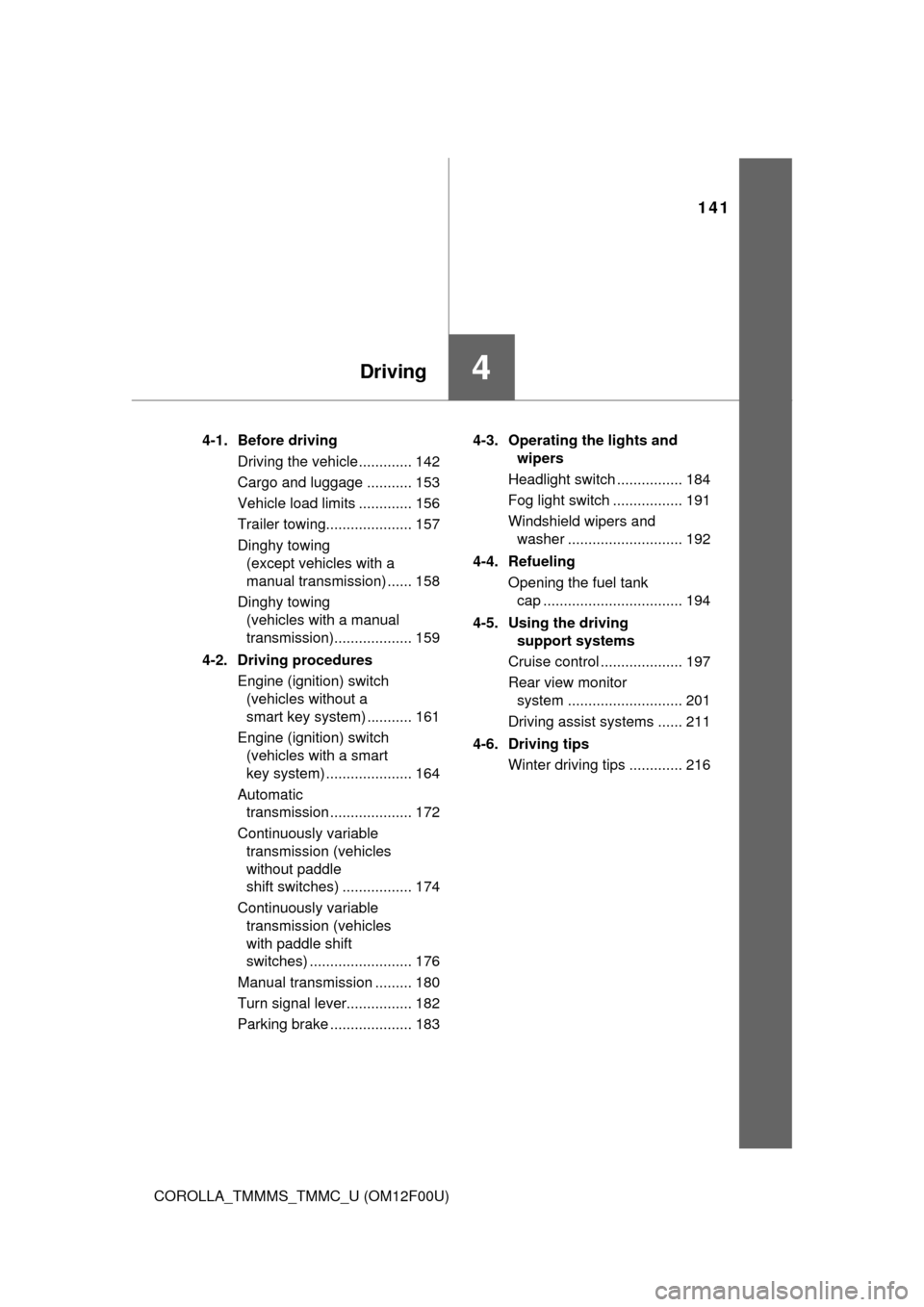
141
4Driving
COROLLA_TMMMS_TMMC_U (OM12F00U)4-1. Before driving
Driving the vehicle ............. 142
Cargo and luggage ........... 153
Vehicle load limits ............. 156
Trailer towing..................... 157
Dinghy towing (except vehicles with a
manual transmission) ...... 158
Dinghy towing (vehicles with a manual
transmission)................... 159
4-2. Driving procedures Engine (ignition) switch (vehicles without a
smart key system) ........... 161
Engine (ignition) switch (vehicles with a smart
key system) ..................... 164
Automatic transmission .................... 172
Continuously variable transmission (vehicles
without paddle
shift switches) ................. 174
Continuously variable transmission (vehicles
with paddle shift
switches) ......................... 176
Manual transmission ......... 180
Turn signal lever................ 182
Parking brake .................... 183 4-3. Operating the lights and
wipers
Headlight switch ................ 184
Fog light switch ................. 191
Windshield wipers and washer ............................ 192
4-4. Refueling Opening the fuel tank cap .................................. 194
4-5. Using the driving support systems
Cruise control .................... 197
Rear view monitor system ............................ 201
Driving assist systems ...... 211
4-6. Driving tips Winter driving tips ............. 216
Page 194 of 612
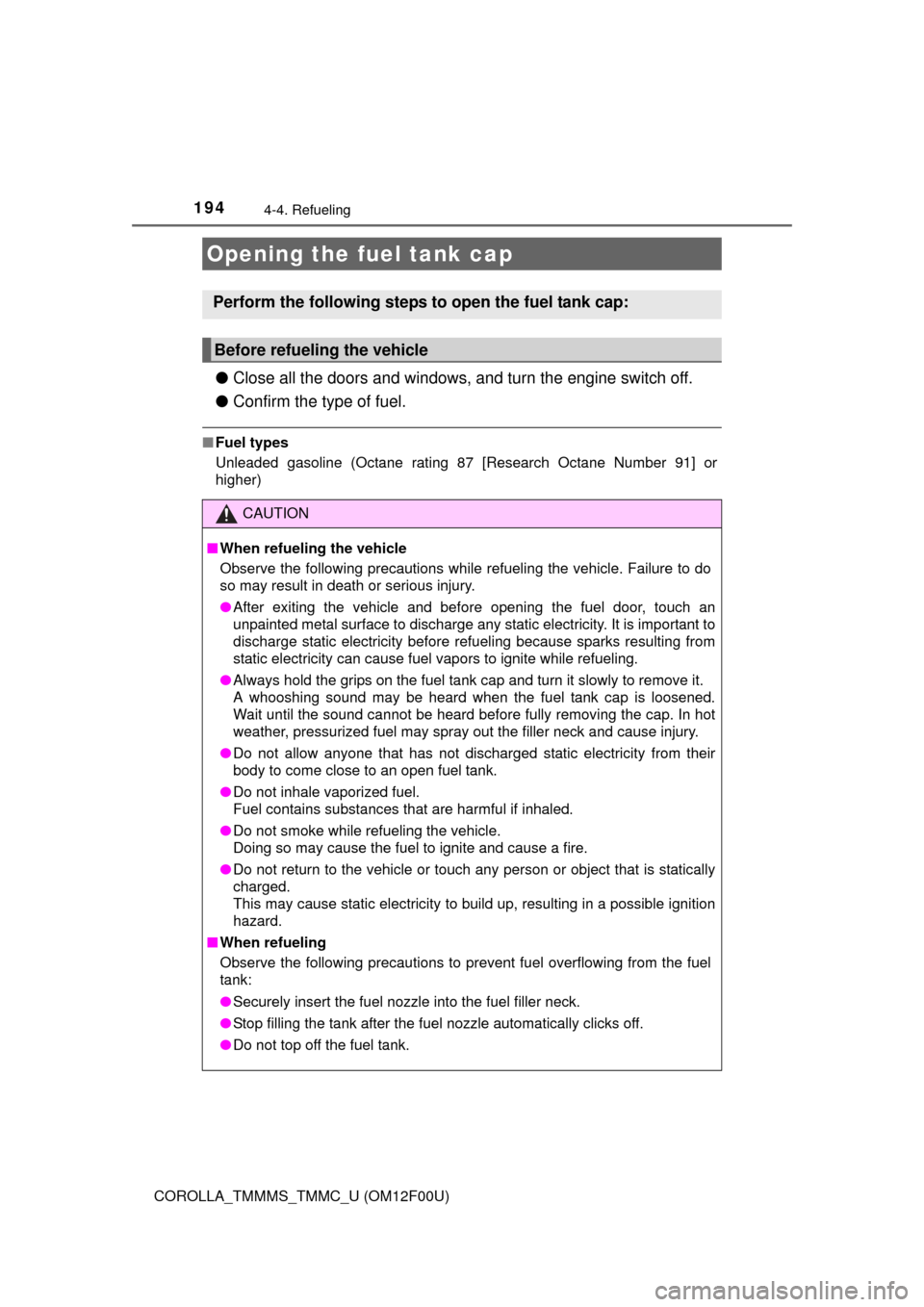
194
COROLLA_TMMMS_TMMC_U (OM12F00U)
4-4. Refueling
●Close all the doors and windows, and turn the engine switch off.
● Confirm the type of fuel.
■Fuel types
Unleaded gasoline (Octane rating 87 [Research Octane Number 91] or
higher)
Opening the fuel tank cap
Perform the following steps to open the fuel tank cap:
Before refueling the vehicle
CAUTION
■When refueling the vehicle
Observe the following precautions while refueling the vehicle. Failure to do
so may result in death or serious injury.
● After exiting the vehicle and before opening the fuel door, touch an
unpainted metal surface to discharge any static electricity. It is important to
discharge static electricity before refueling because sparks resulting from
static electricity can cause fuel vapors to ignite while refueling.
● Always hold the grips on the fuel tank cap and turn it slowly to remove it.
A whooshing sound may be heard when the fuel tank cap is loosened.
Wait until the sound cannot be heard before fully removing the cap. In hot
weather, pressurized fuel may spray out the filler neck and cause injury.
● Do not allow anyone that has not discharged static electricity from their
body to come close to an open fuel tank.
● Do not inhale vaporized fuel.
Fuel contains substances that are harmful if inhaled.
● Do not smoke while refueling the vehicle.
Doing so may cause the fuel to ignite and cause a fire.
● Do not return to the vehicle or touch any person or object that is statically
charged.
This may cause static electricity to build up, resulting in a possible ignition
hazard.
■ When refueling
Observe the following precautions to prevent fuel overflowing from the fuel
tank:
● Securely insert the fuel nozzle into the fuel filler neck.
● Stop filling the tank after the fuel nozzle automatically clicks off.
● Do not top off the fuel tank.
Page 195 of 612
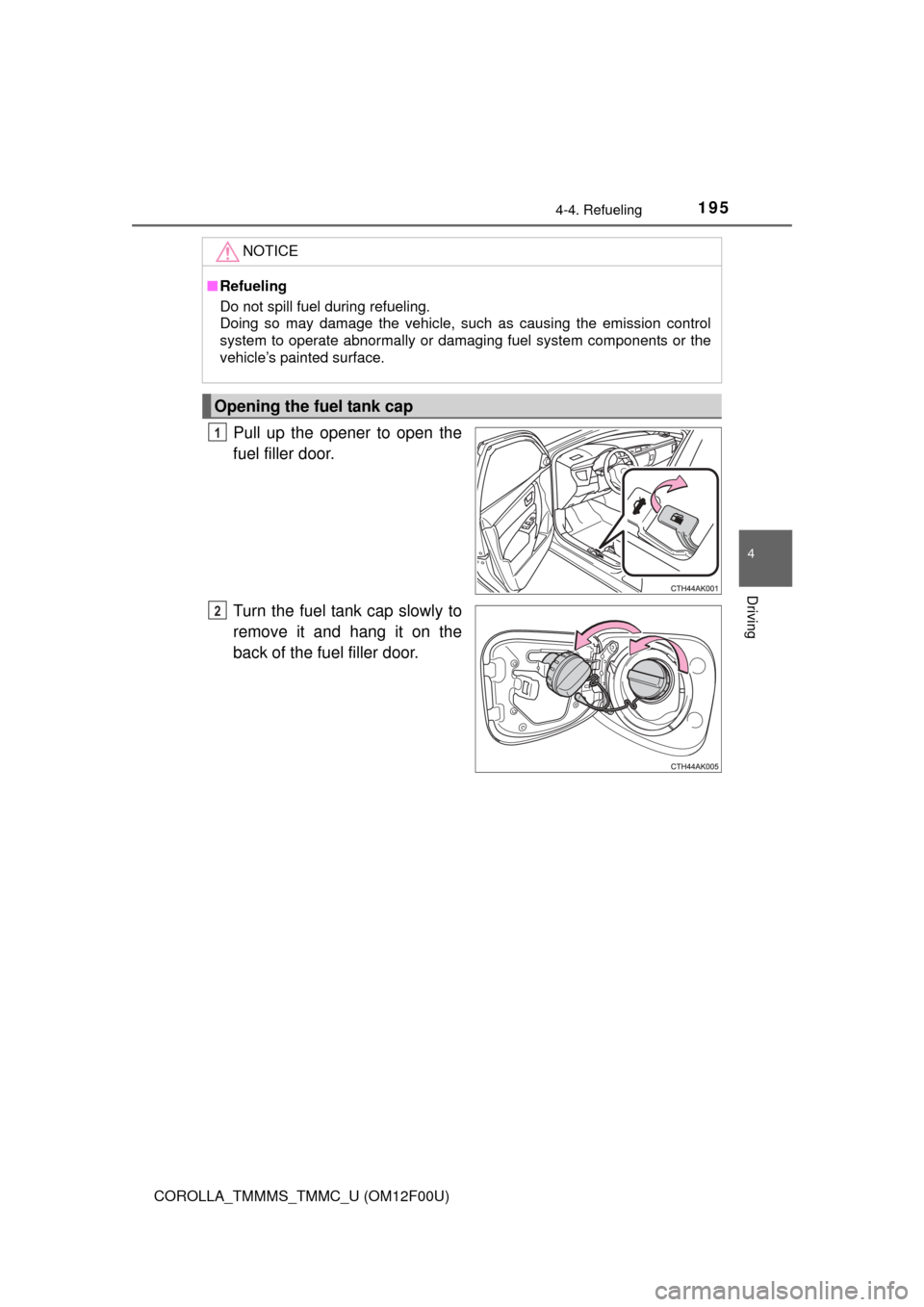
1954-4. Refueling
4
Driving
COROLLA_TMMMS_TMMC_U (OM12F00U)
Pull up the opener to open the
fuel filler door.
Turn the fuel tank cap slowly to
remove it and hang it on the
back of the fuel filler door.
NOTICE
■Refueling
Do not spill fuel during refueling.
Doing so may damage the vehicle, such as causing the emission control
system to operate abnormally or damaging fuel system components or the
vehicle’s painted surface.
Opening the fuel tank cap
1
2
Page 196 of 612
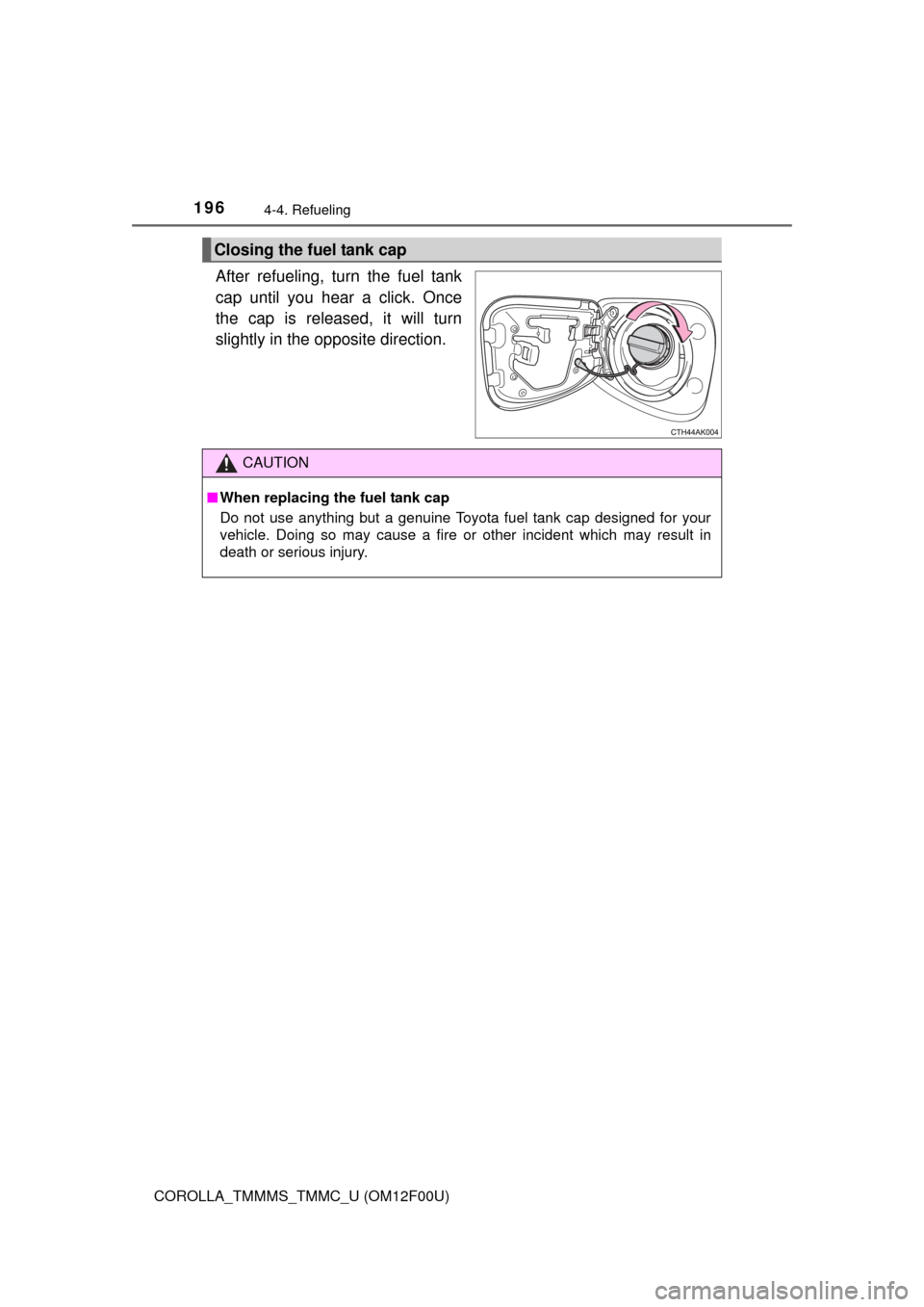
1964-4. Refueling
COROLLA_TMMMS_TMMC_U (OM12F00U)
After refueling, turn the fuel tank
cap until you hear a click. Once
the cap is released, it will turn
slightly in the opposite direction.
Closing the fuel tank cap
CAUTION
■When replacing the fuel tank cap
Do not use anything but a genuine Toyota fuel tank cap designed for your
vehicle. Doing so may cause a fire or other incident which may result in
death or serious injury.
Page 391 of 612
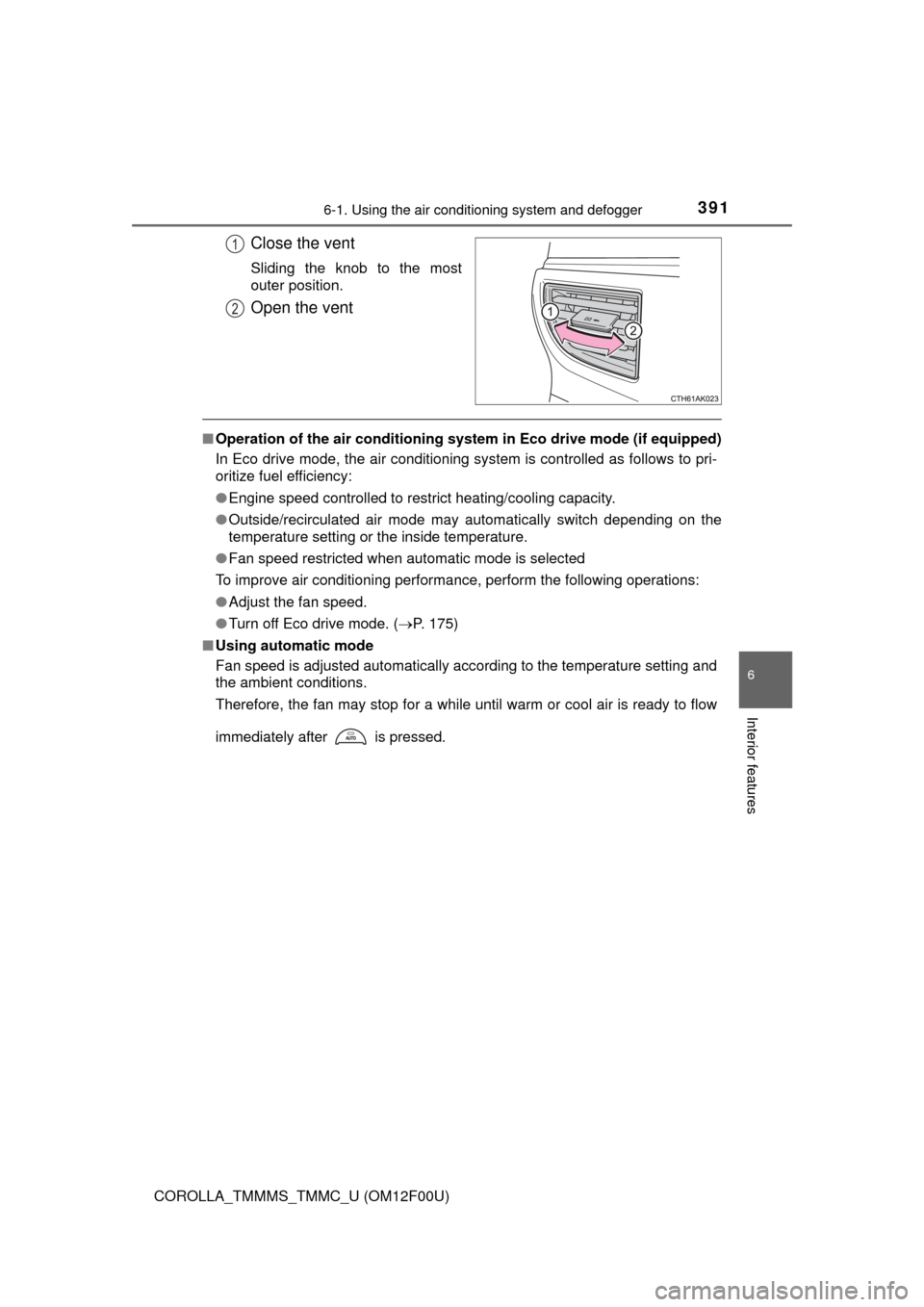
3916-1. Using the air conditioning system and defogger
6
Interior features
COROLLA_TMMMS_TMMC_U (OM12F00U)
Close the vent
Sliding the knob to the most
outer position.
Open the vent
■Operation of the air conditioning system in Eco drive mode (if equipped)
In Eco drive mode, the air conditioning system is controlled as follows to pri-
oritize fuel efficiency:
● Engine speed controlled to restrict heating/cooling capacity.
● Outside/recirculated air mode may automatically switch depending on the
temperature setting or the inside temperature.
● Fan speed restricted when automatic mode is selected
To improve air conditioning performance, perform the following operations:
● Adjust the fan speed.
● Turn off Eco drive mode. ( P. 175)
■ Using automatic mode
Fan speed is adjusted automatically according to the temperature setting and
the ambient conditions.
Therefore, the fan may stop for a while until warm or cool air is ready to flow
immediately after is pressed.
1
2
Page 427 of 612
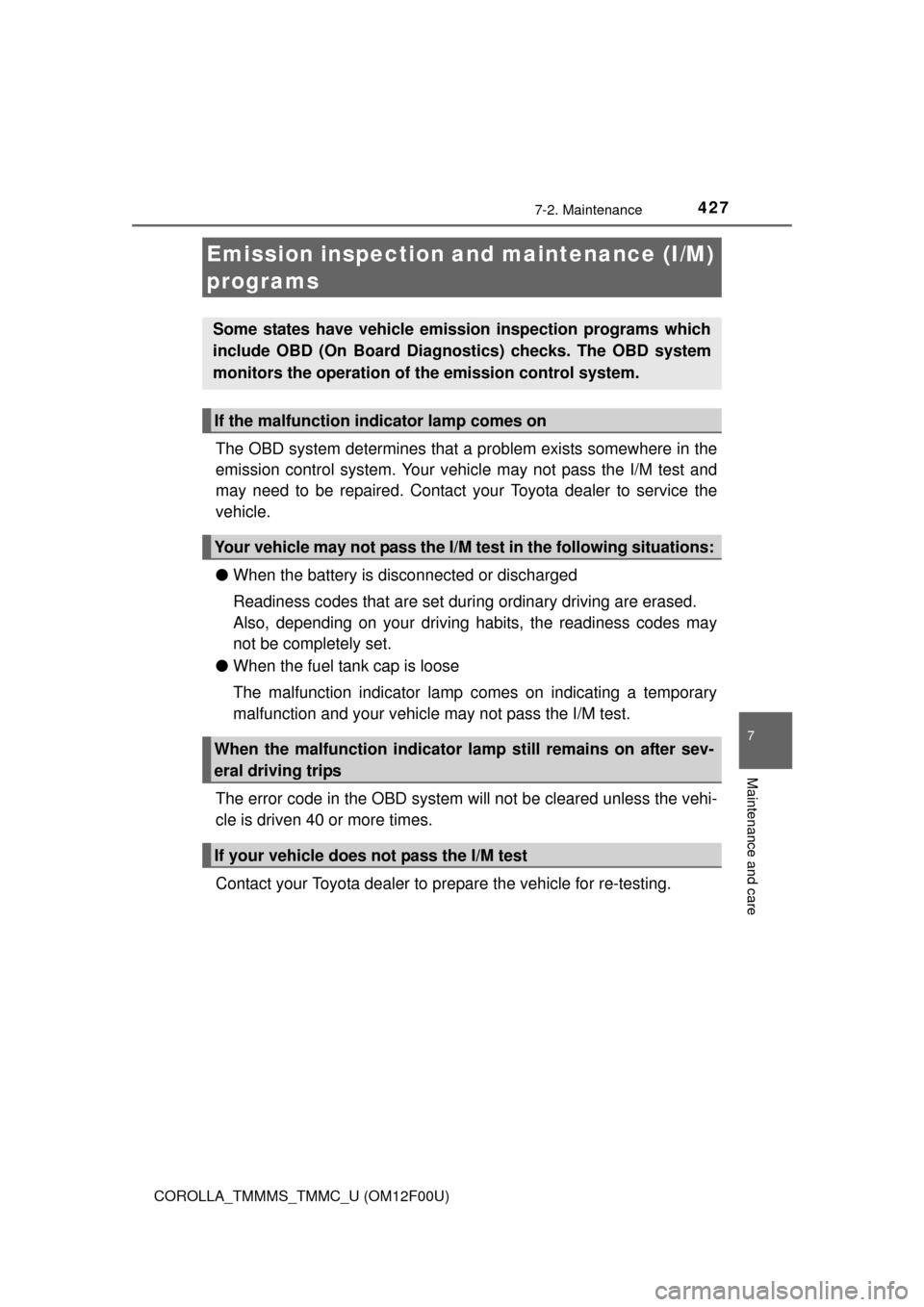
4277-2. Maintenance
7
Maintenance and care
COROLLA_TMMMS_TMMC_U (OM12F00U)
The OBD system determines that a problem exists somewhere in the
emission control system. Your vehicle may not pass the I/M test and
may need to be repaired. Contact your Toyota dealer to service the
vehicle.
● When the battery is disconnected or discharged
Readiness codes that are set duri ng ordinary driving are erased.
Also, depending on your driving habits, the readiness codes may
not be completely set.
● When the fuel tank cap is loose
The malfunction indicator lamp comes on indicating a temporary
malfunction and your vehicle may not pass the I/M test.
The error code in the OBD system will not be cleared unless the vehi-
cle is driven 40 or more times.
Contact your Toyota dealer to prepare the vehicle for re-testing.
Emission inspection an d maintenance (I/M)
programs
Some states have vehicle emission inspection programs which
include OBD (On Board Diagnos tics) checks. The OBD system
monitors the operation of the emission control system.
If the malfunction indicator lamp comes on
Your vehicle may not pass the I/M test in the following situations:
When the malfunction indicator lamp still remains on after sev-
eral driving trips
If your vehicle does not pass the I/M test